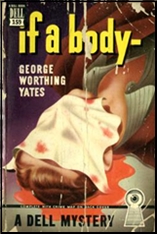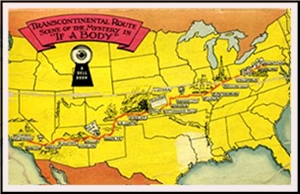Fri 2 Jul 2021
GEORGE WORTHING YATES – If a Body. Hazlitt G. B. Woar #3. Morrow, hardcover, 1941. Triangle, hardcover reprint, 1942. Dell 159, paperback, mapback edition, 1947.
Someone reading this may come up with another example – and if so, it would be most welcome – but at the moment I think the murder investigation in this book could easily be unique: it takes place during a cross-country drive clear across the US, from a dinky tourist camp in eastern Ohio to some cabins for rent in Palmyra Hot Springs, a tiny town in the desert within shouting distance of Los Angeles, California.

Of the 15 travelers, couples and families, who stopped for the first night in a rainstorm, only 14 leave. The death of one of them the authorities rule an accident, but a secret pact between some of them indicates that not only did they know that something was fishy about the death, but they’d also rather hush up about their suspicions so their travel plans would not be delayed.
But what this somehow means is that they end up taking the same route, their paths constantly crossing and overlapping each others. Two of them are husband and wife: Hazitt Woar and his new wife Kathern. They are on their honeymoon. His past includes a stint as a British detective, but in the previous book he ended up on the wrong side of the law in the US, and they are traveling under fictitious names and doing their best to avoid wanted posters as they go.
But Woar’s instincts as a detective cannot be denied, and to his new wife’s extreme frustration and displeasure, he finds he cannot deny his true calling. (At the end of the book, she gives in and allows him to start a new life in San Francisco as a private detective. Unfortunately this was the last of Woar’s three recorded adventures.)
This book took me a long time to read. An investigation conducted under such stretched out circumstances meant that the long middle section was continuously bogged down, especially while Woar is trying to keep his identity a secret at the same time he’s trying to solve a murder which may not be a murder at all.
While not deeply depicted, the characters are interesting, though, and individual people. And there are reasons their paths keep coming together every evening, which is due to very clever writing on Yates’s part. The ending is quite chaotic, though, and if I’m reading it right, the killer’s identity is revealed several pages before Woar explains all.
If you decide to read this anyway, after reading these observations and comments of mine, do it for fun, which it is. The details (and considerable pitfalls) of driving cross-country in the early 1940s are worth the price of admission in themselves.

The Hazlitt G. B. Woar series –
The Body That Came by Post. Morrow 1937.
The Body That Wasn’t Uncle. Morrow 1939.
If a Body. Morrow 1941.
July 3rd, 2021 at 12:22 am
Yates was a popular writer in the slicks and a screenwriter whose credits include the Lone Ranger serial and its sequel, The Falcon in Mexico, Them! and many others (including numerous other SF films after Them!). This particular book seemed to me almost designed as a serial for the slicks and eventual film with the episodic nature and the structure of the book.
As a mystery it does have its flaws, but it also has some virtues as a product of its time, enough so I wouldn’t mind reading the stories surrounding it, and while it has been years since I read it I recall liking the hero and wife as an attractive take on husband and wife mystery series.
July 3rd, 2021 at 12:27 am
And you forgot the most important character. Woar’s bulldog Caligula!
July 3rd, 2021 at 7:05 am
You are right. The husband and wife combo in IF A BODY were quite a remarkable pair. Caligua though I thought was a non-factor until the ending, at which point you’re right again. All of a sudden he certainly does become the book’s most important character.
July 3rd, 2021 at 6:54 pm
BTW, the fellow who did the map on the back cover of the Dell edition outdid himself (or herself) on this one.
Not only is the map totally correct, but there’s a small drawing that corresponds to something that’s somehow significant that relates to each overnight stop along the way.
July 3rd, 2021 at 11:35 pm
I see where the Kindle edition is for sale for $1.99.
July 4th, 2021 at 9:00 am
So it is. Thanks, Chuck. I see it has the Dell front cover. I wonder if the Kindle version has the back cover too.
July 4th, 2021 at 10:43 am
The Kindle version does have the map.